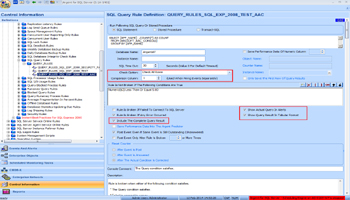How To Set SQL Query Rules To Fire Events For Individual Rows
A typical SQL Query Rule looks like this:
A SQL Query can return between zero and n rows – 0 rows, a single row, or multiple rows
Customers have the option to treat the whole query result as a single entity, or to treat each row independently, that is, to treat each returned row as its own result
This has implications in two areas: number of events fired, and how corrective action is processed
The following table illustrates this:
| Number of Events That Are Fired |
A single event is fired and all the rows breaking the Rule are included in the same event |
One event is fired for
each row breaking the Rule |
| Automatic Correction |
The condition is regarded as corrected only if no row breaks the Rule |
Condition is considered corrected if the single row that previously broke the Rule has been corrected and this row now no longer breaks the Rule |
Note:
The field ‘Comparison Column‘ should be specified to uniquely identify the row, so that the Argent Automatic Correction can correctly identify the row
The SQL Query Rule option ‘Include The Complete Query Result‘ is used to control how many rows should be checked
You should uncheck this option if the whole query result is treated as one entity, or huge number of rows are returned
When this option is unchecked, Argent stops reading rows when the first row matching the criteria is encountered; check this option and all matching rows are returned
The Rule option ‘Comparison Column (Used When Firing Events Separately)‘ should be set to the column number (starting from 1) if firing one event for each matching row
